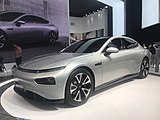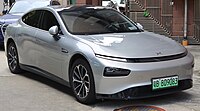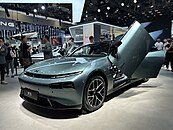XPeng P7
| XPeng P7 | |
|---|---|
 XPeng P7 | |
| Overview | |
| Manufacturer | XPeng |
| Production | June 2020–present |
| Assembly | Zhaoqing, China |
| Designer | Rafik Ferrag[1] |
| Body and chassis | |
| Class | Executive car (E)[2][3] |
| Body style | 4-door fastback sedan |
| Layout |
|
| Platform | SEPA (Smart Electric Platform Architecture) |
| Doors |
|
| Powertrain | |
| Electric motor | 196 kW (263 hp; 266 PS) Permanent Magnet Synchronous Reluctance Motor 316 kW (424 hp; 430 PS) (4WD) Permanent Magnet Synchronous Reluctance Motor |
| Transmission | 1-speed fixed gear |
| Battery | 80.87 kWh (291.1 MJ) lithium ion[4] |
| Electric range |
|
| Dimensions | |
| Wheelbase | 2,998 mm (118.0 in) |
| Length | 4,880 mm (192 in) |
| Width | 1,896 mm (74.6 in) |
| Height | 1,450 mm (57 in) |
| Curb weight | 1865 kg RWD Long Range 1910 kg RWD Super Long Range 2060 kg 4WD Performance |
The XPeng P7 (Chinese: 小鹏P7; pinyin: Xiǎopéng P7) is a battery-powered executive sedan made by the Chinese electric car company XPeng, which started deliveries in the Chinese market on 29 June 2020.[6][7] Later, a refreshed version called the XPeng P7i was released in 2023. On October 10, 2024 the XPeng P7+ was revealed as a larger, cheaper version of the P7i.
Overview
[edit]The XPeng P7 debuted as a semi-concept car on the 2019 Auto Shanghai show in April 2019. On November 30, 2019, the production model was unveiled at the Auto Guangzhou 2019.[8]
-
XPeng P7 Concept
-
XPeng P7 Concept rear quarter
Production model
[edit]As a midsize electric sedan, the XPeng P7 is a direct competitor to the Tesla Model 3. As XPeng's second model after the G3, the range of the new sedan will be improved compared to the G3. According to the official release, the size of the XPeng P7 will be larger than most mid-size cars, with a wheelbase typical of mid-to-large size vehicles. In terms of battery life, the company said that "the range will be greatly improved"[9] with a range of 562 to 706 km (349 to 439 mi) (NEDC) claimed. The XPeng P7 made its world debut at the 2019 Auto Shanghai show.[10] Deliveries to customers started on 29 June 2020.[6][7][11]
-
XPeng P7
-
XPeng P7 rear quarter
As of February 2021[update], listing images of an updated version of the P7 powered by lithium iron phosphate battery supplied by Contemporary Amperex Technology Co. Limited (CATL) surfaced. The lithium iron phosphate battery powered models share the same design and features of the regular nickel cobalt manganese (also known as NCM or Ternary) lithium-ion battery models, and is powered by a 80 kW (107 hp; 109 PS) electric motor with the maximum output of 196 kW (263 hp; 266 PS).[12]
On November 20, 2021, the Xpeng P7 Wing limited edition was released.[citation needed]
-
P7 Wing Edition (front view)
-
P7 Wing Edition (rear view)
XPeng P7i
[edit]The XPeng P7i is the refreshed version of the XPeng P7 for 2023. The facelift features the second generation XNGP XPeng intelligent driving assist system also found in the G9, with two additional radars, and Orin-X chips replacing the Xavier chips found in the original P7, providing up to 508TOPS of calculation ability compared to the previous 30TOPS. This allows for the introduction of two self driving modes, the first of which is called 'City NGP' which is a fully self driving system that relies on high-definition mapping, and is only available in Shanghai, Guangzhou and Shenzhen at launch. The second system is called 'LCC' and works as a lane-centering cruise control which can obey traffic signals and cross intersections, but is not capable of making turns; it is usable in all parts of China. An update expected in the second half of 2023 will allow the 'City NGP' mode to function without high-definition maps, allowing for use anywhere in China.
The powertrain received an update with, rear wheel drive models now producing 203 kW (272 hp; 276 PS) and 440 N⋅m (325 lb⋅ft) of torque, while Performance variants add a 145 kW front induction motor for all-wheel drive and now produce a total of 348 kW (467 hp; 473 PS) and 757 N⋅m (558 lb⋅ft) of torque with an improved 0–100 km/h (0–62 mph) time of 3.9 seconds.[13] These output increases were achieved by increasing the cooling capacity while retaining the same motors, allowing for sustained travel at 190 kilometres per hour (118 mph) for up to 30 minutes without overheating. CLTC range for rear-wheel drive models is 702 kilometres (436 mi) and 610 kilometres (379 mi) for performance models.
It is 8 mm (0.31 in) than the P7 due to revised rear body panels and taillight changes, but all other dimensions remain the same. The interior features several materials upgrades, including Nappa leather seats and a redesigned steering wheel and lower dashboard; additionally, the chipset running the dashboard screens has been upgraded to the Snapdragon SA8155P. A heat pump now comes standard, along with an electric motorized door option and an external trunk release. There is now an twenty-speaker Dynaudio sound system with Dolby Atmos software.[14]
-
2023 XPeng P7i Wing Edition
-
Rear view
| Model name | Power | Torque | Battery | Range (CLTC) | Top Speed | 0-100 time |
|---|---|---|---|---|---|---|
| P7 480 | 196 kW (263 hp; 266 PS) | 390 N⋅m (288 lb⋅ft) | 60.2 kWh LFP CATL | 480 km (298 mi) | 170 km/h (106 mph) | 6.7 s |
| P7 586 | 70.8 kWh NMC CALB | 586 km (364 mi) | ||||
| P7 625 | 77.9 kWh NMC | 625 km (388 mi) | ||||
| P7 670 | 80.9 kWh NMC CATL | 670 km (416 mi) | ||||
| P7 706 | 706 km (439 mi) | |||||
| P7 4WD Performance | 120 kW front
196 kW rear 316 kW (424 hp; 430 PS) total |
655 N⋅m (483 lb⋅ft) | 562 km (349 mi) | 4.3 s | ||
| P7i 550 | 203 kW (272 hp; 276 PS) | 440 N⋅m (325 lb⋅ft) | 64.4 kWh LFP EVE Power | 550 km (342 mi) | 200 km/h (124 mph) | 6.4 s |
| P7i 702 | 86.2 kWh NMC CALB | 702 km (436 mi) | ||||
| P7i Performance | 145 kW front
203 kW rear 348 kW (467 hp; 473 PS) total |
757 N⋅m (558 lb⋅ft) | 610 km (379 mi) | 3.9 s |
Technology
[edit]Adaptive cruise control system
[edit]XPeng P7 is equipped with an adaptive cruise control system. The adaptive cruise control (ACC) system is a safety system designed for avoiding collisions by collecting environmental data from vehicle sensors to control the velocity of vehicles. According to data in 2020, this system had been used for driving for 25.1 million km (15.6 million mi), which the using rate of ACC is 66%.[15]
AGX-Xavier central computer
[edit]XPeng P7 has many sensors, radars and cameras for 360-degree environment detection. After the process of data collection, Nvidia Drive AGX Xavier, which is the central high-performance computer equipped in P7, would utilize and calculate data to perform P7's Xmart OS functions, such as automated driving and valet parking.[16]
Autonomous driving assistance system
[edit]XPeng P7's XPILOT 3.0 is an autonomous driving assistance system that features XPeng Navigation Guided Pilot (XNGP). According to the data offered by Marie Cheung, it has:
- 31 autonomous driving sensors;
- 12 ultrasonic sensors;
- 10 autonomous driving high-sensitivity cameras and sub-systems;
- 5 high-precision millimeter wave radars;
- 4 autonomous driving surround-view cameras.
This equipment gives the XPeng P7 omnidirectional perception to supervise the changes of the surrounding environment.[17]
XPeng P7+
[edit]| XPeng P7+ | |
|---|---|
| Overview | |
| Manufacturer | XPeng (小鹏) |
| Model code | F57 |
| Production | 2024–present |
| Assembly | China: Guangzhou, Guangdong |
| Body and chassis | |
| Body style | 5-door liftback |
| Platform | SEPA 2.0 |
| Powertrain | |
| Electric motor | 180 kW 230 kW |
| Battery | 60.7 kWh LFP 76.3 kWh LFP |
| Electric range | 620–710 km (390–440 mi) ([[ China Light-Duty Vehicle Test Cycle|CLTC]]) |
| Dimensions | |
| Wheelbase | 3,000 mm (120 in) |
| Length | 5,056 mm (199.1 in) |
| Width | 1,937 mm (76.3 in) |
| Height | 1,512 mm (59.5 in) |
| Curb weight | 1,967–2,037 kg (4,336–4,491 lb) |
The XPeng P7+ was revealed in China on October 10, 2024 and internationally at the Paris Motor Show four days later, and is a larger and cheaper version of the P7i, which it will be sold alongside.[18] It has a longer wheelbase and features XPeng's first implementation of a 'vision only' autonomous driving system. Named 'AI Hawk', it uses two Nvidia Orin X chips providing 508 TOPS of compute, along with a series of eleven cameras, three mmwave radars, and twelve ultrasonic sensors, but lacks LiDAR in its sensor suite. It uses the industry's first implementation of single pixel LOFIC (lateral overflow integration capacitor) camera sensors, which are better able to deal with high contrast lighting scenarios such as backlighting or headlight glare during nighttime.[19]
While the wheelbase is about the same as the P7i, the overall length of the car is 168 mm (6.6 in) longer. This allows for increased interior space, a significant criticism of the P7i, with a front seating space of 956 mm (37.6 in), and 994 mm (39.1 in) in the rear. Both the front and rear seats have heated, ventilated, and massaging seats as standard. The driver's seat has up to 12-way power seat adjustments, and the rear seats have a power seat recline adjustment.
The P7+ has a near buttonless dashboard, with nearly all controls placed in the 15.6-inch center infotainment touchscreen; the 10.25-inch digital instrument panel is controlled by two sets of button and scroll controls mounted on the two-spoke steering wheel, which are powered by a Qualcomm Snapdragon 8295 SoC. Ahead of the center console armrest is a set of two cupholders and dual ventilated wireless charging pads.
On the rear of the center console is a pair of vents and a touchscreen for the rear passengers. The touchscreen houses controls for the seats' heating, ventilation, and massage functions, controls for the rear climate control zone, and media controls with the ability to play videos. The back of the front seats have a folding tray table similar to airline seats, and there are controls to move the front passenger seat forward to provide more legroom. The rear seatbacks can also be reclined by up to 10 degrees.
The roof is spanned by a tinted 2.1-square-metre (23 sq ft) panoramic sunroof that lacks a sunshade. The XPeng developed sound system consists of twenty Dynaudio-sourced speakers imported from Germany in a 7.1.4 panoramic configuration. It includes a speaker integrated into the driver's seat headrest which will provide audio from navigation prompts and phone calls without interrupting audio for the rest of the cabin.
The P7+ has a power rear liftgate which reveals a trunk with 725 liters (192 U.S. gal) of space, which expands to 2,221 liters (587 U.S. gal) with the rear seats folded down. It also has an underfloor compartment, but lacks a frunk despite having an opening hood.
The P7+ comes with a choice of two lithium iron phosphate batteries of either 60.7 kWh or 76.3 kWh capacities, sourced from Eve Power. Both batteries use an 800 V electrical platform using silicon carbide electronics, and support up to 3C charging from 5C chargers, resulting in a claimed 30-80% charge time of 16 minutes. The P7+ comes with a single 180 kW (241 hp; 245 PS) motor standard, with higher models receiving a single 230 kW (308 hp; 313 PS) unit, both produced by XPeng in Wuhan. It has a top speed of 200 kilometres per hour (124 mph).[20]
It has a drag coefficient of 0.206 and has active grille shutters. The chassis has a double wishbone suspension at the front and a multilink independent suspension at the rear.
At launch in China, customers could put down a refundable CN¥ 99 (approximately US$14) pre-order deposit which would provide a CN¥ 3,000 (approximately US$420) total purchase discount, leading to 30,000 pre-orders only 1 hour and 48 minutes after opening.
| Power | Torque | Battery | Range (CLTC) | 0-100 |
|---|---|---|---|---|
| 180 kW (241 hp; 245 PS) | 450 N⋅m (332 lb⋅ft) | 60.7kWh LFP | 602–620 km (374–385 mi) | 7.0 s |
| 230–235 kW (308–315 hp; 313–320 PS) | 450 N⋅m (332 lb⋅ft) | 76.3kWh LFP | 710 km (441 mi) | 5.9 s |
Awards
[edit]The Xpeng P7 won the Xuanyuan Awards Car of The Year 2021.[21]
Safety
[edit]| Test | Points | % |
|---|---|---|
| Overall: | ||
| Adult occupant: | 35 | 87% |
| Child occupant: | 40 | 81% |
| Pedestrian: | 51.5 | 81% |
| Safety assist: | 14.2 | 78% |
In media
[edit]- On September 8, 2022, the Xpeng P7 was added to the videogame Forza Horizon 5 as part of the Rami's Racing History update, initially obtainable for free by completing in-game seasonal events from the 8th to the 15th.[23]
- Forza Motorsport (2023)
- Need for Speed Assemble (2024)[24]
Sales
[edit]Total XPeng sales in the Chinese market passed the 10,000 mark after less than six months after the introduction of the P7.[25]
References
[edit]- ^ Smith, Karl (16 April 2019). "Shanghai 2019: XPeng P7 Coupé". Car Design News. Retrieved 19 January 2020.
- ^ https://ev-database.org/car/1823/XPENG-P7-Wing-Edition
- ^ https://cleantechnica.com/2023/08/27/xpeng-p7-sedan-first-impression/
- ^ Jiang, Tianshuang (17 December 2019). 最大功率316kW 小鹏P7动力信息曝光. autohome.com.cn (in Chinese). Retrieved 29 September 2021.
- ^ "Xpeng P7 Driving Range Updated for Multiple Versions" (Press release). XPeng Motors. 15 June 2020. Retrieved 16 June 2020 – via Business Wire.
- ^ a b Krivevski, Blagojce (28 June 2020). "Xpeng Starts Delivery of P7 EV Sports Sedan". Electric Cars Report. Retrieved 28 June 2020.
- ^ a b Moloughney, Tom (15 June 2020). "Exclusive First Drive Report: Xpeng P7 Performance Version". InsideEVs. Retrieved 15 June 2020.
- ^ "Xpeng P7 Electric Sedan Shines At Guangzhou Motor Show". InsideEVs.com. Retrieved 8 December 2021.
- ^ Xie, Yu (16 April 2019). "Chinese electric vehicle maker Xpeng unveils P7 four-door coupe at Auto Shanghai 2019, months after SUV roll out". South China Morning Post. Retrieved 18 April 2019.
- ^ "Xpeng P7 intelligent electric coupe debuts at Auto Shanghai 2019". xiaopeng.com. 16 April 2019. Archived from the original on 8 May 2019. Retrieved 16 April 2019.
- ^ Dixon, Tom (18 April 2019). "Xpeng Motors Unveils Xpeng P7 At Auto Shanghai 2019". CleanTechnica. Retrieved 18 April 2019.
- ^ Li, Na (4 February 2021). 宁德时代电池 小鹏P7磷酸铁锂版申报图. autohome.com.cn (in Chinese). Retrieved 4 February 2021.
- ^ Li, Na (10 March 2023). 售24.99-33.99万元 小鹏P7i正式上市. autohome.com.cn (in Chinese). Retrieved 26 June 2023.
- ^ Andrews, Mark (17 April 2023). "Xpeng P7i Test Drive: Hands-Free Driving Comes to Life". CarNewsChina.com. Retrieved 2 November 2024.
- ^ Tan, Hong; Zhao, Fuquan; Liu, Zongwei (5 April 2021). "Impact of adaptive cruise control (ACC) system on fatality and injury reduction in China". Traffic Injury Prevention. 22 (4): 307–312. doi:10.1080/15389588.2021.1896715. ISSN 1538-9588. PMID 33819126. S2CID 233037336.
- ^ Cvijetic, Neda; Tomazin, Tom (1 February 2021). "Entwicklung einer zentralisierten Rechnerarchitektur für autonome Fahrzeuge". ATZelektronik (in German). 16 (1): 18–23. doi:10.1007/s35658-020-0569-4. ISSN 2192-8878. S2CID 234018002.
- ^ Cheung, Marie (15 July 2021). "XPeng P7 Leads Industry with First i-VISTA 5-Star Smart Car Rating". Business Wire.
- ^ Bobylev, Denis (10 October 2024). "Xpeng P7+ officially revealed in China with next-gen AD platform". CarNewsChina.com. Retrieved 1 November 2024.
- ^ Andrews, Mark (31 October 2024). "Driving Review | Xpeng P7+ a car more for family than driving". CarNewsChina.com. Retrieved 1 November 2024.
- ^ Andrews, Mark (12 July 2024). "Xpeng P7+ key details revealed by regulator – it does not have Lidar". CarNewsChina.com. Retrieved 1 November 2024.
- ^ Cheung, Marie (14 December 2020). "Xpeng P7 receives Car of the Year 2021 Award in Xuanyuan Awards". Xpeng Inc.
- ^ https://cdn.euroncap.com/media/78437/euroncap-2023-xpeng-p7-datasheet.pdf
- ^ Princewell, Hillary (9 September 2022). "XPeng P7 EV Now Available on Forza Horizon". CarNewsChina.com. Retrieved 12 September 2022.
- ^ "2020 Xpeng P7- Need for Speed Assemble". www.igcd.net. Retrieved 17 July 2024.
- ^ Kane, Mark (5 December 2020). "China: Xpeng More Than Quadrupled EV Sales In November 2020". InsideEVs. Retrieved 29 September 2021.
External links
[edit]- Official website

- Official website (in Chinese)








